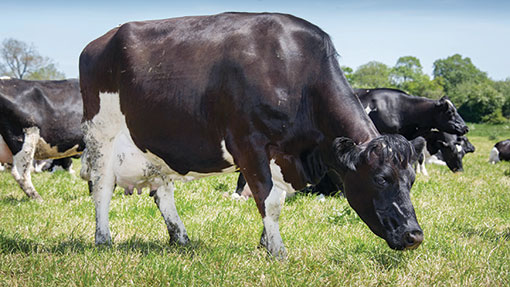Survey reveals £109/t difference in the cost of growing grass

Well-managed, grazed grass in dairy systems has been shown to deliver a 100% return on the cost of growing it.
According to a three-year study of Welsh dairy farms, pasture is worth £197/t dry matter, but costs just £97/t DM to grow – 25% less than other forages.
But to cash in on its value, grass must be grazed efficiently. The project farms that used nearly 13t/ha DM (grazed grass plus excess made into silage) achieved a net margin of £2,250/ha. In comparison, the margin of those that used less than 6t/ha DM was under £1,500/ha.
On average, the farms in the study retained 31% of their output as profit over the three-year period. In comparison, the top 25% DairyCo Milkbench farms in 2013 retained 22%.
See also Farmers warned over varied first-cut silage quality
John Owen, who led the study, says it proves the value of grass, providing it is used effectively.
“Simply growing grass does not mean it will be cheap and cost effective; it needs to be grown and utilised efficiently. There was a strong correlation between the farms in the study that grew the most grass and those that utilised it.
“Even within this project, which evaluated farmers who were focused on efficient grass production and utilisation, there was a range of £109/t DM in growing costs between the best and the worst paddocks across all the project farms.”
In monetary terms, this difference (8.3t) amounted to £404/ha. The best paddocks produced 15.2t/ha DM at a cost of £40/t.
Twelve Welsh dairy farms – 10 conventional and two organic – were monitored. Average annual rainfall over the three years was 1,070 mm (43in) and the farms were grazed for an average of 37 weeks.
The Grass Value study, which formed part of the European and Welsh government-funded Improving the Welsh Dairy Supply Chain initiative, gave an interesting result on grass production in an organic system. The best organic paddock produced as much DM as the 10.9t/ha average of the conventionally farmed paddocks.
Reseeding
Another strong message to emerge is that reseeding doesn’t necessarily boost grass yields. In fact the best-performing paddock had not been reseeded for 10 years.
Mr Owen says that with the cost of reseeding in the region of £494/ha, farmers should do so only if a field needs it. “Don’t jump into reseeding. It is more important to make sure the soil nutrient levels are OK,” he says.
“If there is more than 50% ryegrass in the sward then surely that ryegrass must be suited to that land, so why would you plough it up? With good nutrients and grass management, permanent pasture can have a high ryegrass content and be as productive as many younger leys.”
The heaviest soil grew the most grass – 11.5t/ha DM, compared with medium soil at 10.2t/ha DM and light at 10.4t/ha DM. This was put down to its ability to retain moisture.
Mr Owen, who together with a team of recorders took 40,000 field grass cover measurements, believes all but the highest-yielding herds have the potential to exploit well-managed grazed grass.
“Many herds with yields of up to 9,000 litres a cow achieve a proportion of their yield from forage, with a good share of this from grazing. With the right infrastructure and effective management, grazed grass can replace more expensive conserved forages without compromising yield, leading to increases in herd profitability.”
Research into high-yielding herds
The Scottish Agricultural College has started a new project to evaluate the nutritional value of fresh grass in the diet of high-yielding cows in zero-grazing systems.
Being carried out as part the DairyCo Grassland, Forage and Soils Research Partnership, the study is investigating the effect of increasing the proportion of fresh grass as a percentage of the diet on animal performance and behaviour, forage utilisation and economics. The trial is the first in a series of studies.
The best grassland farmers in the three-year study used nearly13t/ha DM.
